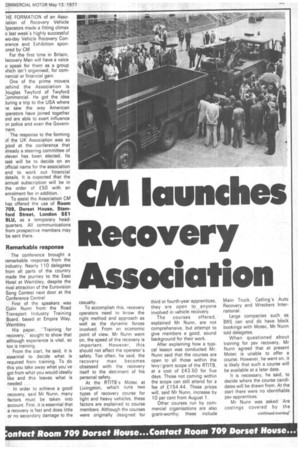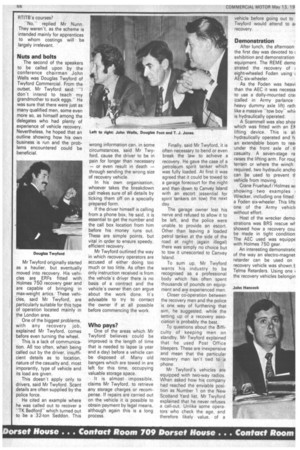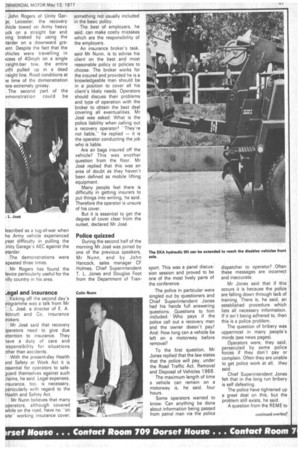CM launches Recovery Association
Page 67

Page 68

Page 69

Page 70

If you've noticed an error in this article please click here to report it so we can fix it.
'HE FORMATION of an Assoiation of Recovery Vehicle. )perators made a fitting climax o last week's highly successful wo-day Vehicle Recovery Conerence and Exhibition soonored by CM.
For the first time in Britain, fecovery Men will have a voice o speak for them as a group vhich isn't organised, for comnercial or financial gain.
One of the prime movers )ehind the Association is )ouglas Twyford of Twyford .ommercial. He got the idea hiring a trip to the USA where le saw the way American )perators have joined together and are able to exert influence )fl police and even the GovernTient.
The response to the forming Df the UK Association was so good at the conference that already a steering committee of eleven has been elected. Its task will be to. decide on an Dfficial name for the association and to work out financial details. It is expected that the annual subscription will be in the order of £50 with an enrolment fee in addition.
To assist the Association CM has offered the use of Room 709, Dorset House, Stamford Street, London SE1 9LU, as a temporary headquarters. All communications from prospective members may be sent there.
Remarkable response
The conference brought a remarkable response from the industry. Nearly 110 delegates from all parts of the country made the journey to the Esso Hotel at Wembley, despite the rival attraction of the Eurovision Song Contest next door at the Conference Centre!
First of the speakers was Colin Nunn from • the Road Transport Industry Training Board, based at Empire Way, Wembley.
His paper, "Training for recovery," sought to show that although experience is vital, so too is training.
From the start, he said, it is essential to decide what is required from training. To do this you take away what you've got from what you would ideally like and this leaves what is needed . . .
In order to achieve a good recovery, said Mr Nunn, many factors must be taken into account. First, it is essential that a recovery is fast and does little or no secondary damage to the casualty.
To accomplish this, recovery operators need to know the right method and approach as well as the dynamic forces involved. From an economic point of view, Mr Nunn went on, the speed of the recovery is important. However, this should not affect the operator's safety. Too often, he said, the recovery man becomes obsessed with the recovery itself to the detriment of his personal safety.
At the RTITB's Motec at Livingston, which runs two types of recovery course for light and heavy vehicles, these factors are explained to course members. Although the courses were originally designed for third or fourth-year apprentices, they are open to anyone involved in vehicle recovery.
The courses offered, explained Mr Nunn, are not comprehensive, but attempt to give members a good, sound background for their work.
After explaining how a typical lesson was conducted Mr. Nunn said that the courses are open to all those within the levy/grant scope of the RTITB, at a cost of £43.50 for five days. Those not coming within the scope can still attend for a fee of £154.44. These prices will, said Mr Nunn, increase by 10 per cent from August 1.
Other courses run by commercial crganisations are also grant-worthy; these include
Main, Truck, Catling's Auto Recovery and Wreckers International.
Large companies such as BRS can and do have block bookings with Motec, Mr Nunn told delegates.
When questioned about training for psv recovery, Mr Nunn agreed that at present Motec is unable to offer a course. However, he went on, it is likely that such a course will be available at a later date.
It is necessary, he said, to decide where the course candidates will be drawn from. At the start there were no identifiable psv apprentices.
Mr Nunn was asked: Are costings covered by the continued overleaf RTITB's courses?
"No," replied Mr Nunn. They weren't, as the scheme is intended mainly for apprentices to whom costings will be largely irrelevant.
Nuts and bolts
The second of the speakers to be called upon by the conference chairman John Wells was Douglas Twyford of Twyford Commercial. From the outset, Mr Twyford said: "I don't intend to teach my grandmother to suck eggs." He was sure that there were just as many qualified men, some even more so, as himself among the delegates who had plenty of experience of vehicle recovery. Nevertheless, he hoped that an outline showing how his own business is run and the problems encountered could be beneficial.
Mr Twyford originally started as a haulier, but eventually moved into recovery. His vehicles are _ _ERFs fitted with Holmes 750 recovery gear and are capable of bringing in max-weight artics.' These vehicles, said Mr Twyford, are particularly suitable for this type of operation located mainly in the London area.
One of the biggest problems, with any recovery job, explained Mr Twyford, comes before even turning the wheel.
This is a lack of communication. All too often, when being called out by the driver, insufficient details as to location, nature of the casualty and, most imporantly, type of vehicle and its load are given.
This doesn't apply only to drivers, said Mr Twyford. Scant details are often supplied by the police force.
He cited an example where he was called out to recover a "TK Bedford" which turned out to be a 32-ton Seddon. This wrong information can, in some circumstances, said Mr Twyford, cause the driver to be in pain for longer than necessary — or even result in death — through sending the wrong size of recovery vehicle.
In his own organisation, whoever takes the breakdown call makes sure of all details by ticking them off on a specially prepared form.
If the driver himself is calling from a phone box, he said, it is essential to get the number and the call box location from him before his money runs out. These are simple points, but vital in order to ensure speedy, efficient recovery.
Mr Twyford outlined the way in which recovery operators are accused of either doing too much or too little. As often the only instruction received is from the vehicle's driver there is no basis of a contract and the vehicle's owner then can argue about the work done. It's advisable to try to contact the owner if at all possible before commencing the work.
Who pays?
One of the areas which Mr Twyford believes could be improved is the length of time that is needed to lapse (a year and a day) before a vehicle can be disposed of. Many old bangers which are towed in are left for this time, occupying valuable storage space.
It is almost impossible, claims Mr Twyford, to retrieve any storage charges or recompense. If repairs are carried out on the vehicle it is possible to obtain payment by legal means, although again this is a long process. Finally, said Mr Twyford, it is often necessary to bend or even break the law to achieve a recovery. He gave the case of a petroleum spirit tanker which was fully loaded. At first it was agreed that it could be towed to a garage forecourt for the night and then down to Canvey Island with an escort (essential for spirit tankers on tow) the next day.
The garage owner lost his nerve and refused to allow it to be left, and the police were unable to provide an escort. Other than leaving a loaded petrol tanker at the side of the road at night (again illegal) there was simply no choice but to tow it unescorted to Canvey Island.
To sum up, Mr Twyford wants his industry to be recognised as a professional body which has often spent thousands of pounds on equipment and are experienced men.
Closer co-operation between the recovery men and the police is one way of furthering that aim, he suggested, while the setting up of a recovery association is probably the best.
To questions about the diff culty of keeping men on standby, Mr Twyford explained that he used Post Office bleepers. These are inexpensive and mean that the particular recovery man isn't tied to a phone.
Mr Twyford's vehicles are equipped with two-way radios. When asked how his company had reached the enviable position as Number 1 on the New Scotland Yard list, Mr Twyford explained that he never refuses a call-out. Unlike some operators who check the age, and therefore likely value, of a vehicle before going out to Twyford would attend to ai recovery.
Demonstration
After lunch, the afternoon the first day was devoted to exhibition and demonstration equipment. The REME demo strated the recovery of ; eight-wheeled Foden using ; AEC six-wheeler.
As the Foden was heavi than the AEC it was necessa to use a dolly-mounted era, (called in Army parlance heavy dummy axle lift) rath like a massive "tow boy" whi( is hydraulically operated.
A Scammell was also shov which was fitted with an El lifting device. This is al: hydraulically operated and h; an extendable boom to real under the front axle of tl casualty. A seven-stage ra raises the lifting arm. For rout terrain or where the winch required, two hydraulic ancho can be used to prevent tf vehicle from moving.
Crane Fruehauf/Holmes w; showing two examples Wrecker, including one fitted • a Foden six-wheeler. This lift€ one of the Army vehick without effort.
Host of the wrecker demo: strations was BRS rescue wh showed how a recovery cou be made in tight condition The AEC used was equippc with Holmes 750 gear.
An interesting demonstratic of the way an electro-magnet retarder can be used on recovery vehicle was shown t Telma Retarders. Using one ( the recovery vehicles belongin John Rogers of Unity Oar
e, Leicester, the recovery :hide towed an Army heavy uck on a straight bar and eing braked by using the itarder on a downward graent. Despite the fact that the ?hides were travelling in The second part of the emonstration could be lescribed as a tug-of-war when he Army vehicle experienced ireat difficulty in pulling the Jnity Garage's AEC against the eta rder. The demonstrations were epeated three times. Mr Rogers has found the levice particularly useful for the iilly country in his area. -egal and insurance Kicking off the second day's )rogramme was a talk from Mr ". L. Jose, a director of E. A. ■ lotcutt and Co, insurance nokers. Mr Jose said that recovery )perators need , to give due attention to insurance. They lave a duty of care and -esponsibility for situations )ther than accidents. With the present-day Health 3nd Safety at Work Act it is essential for operators to safeguard themselves against such :laims, he said. Legal expenses, ,nsurance, too, is necessary, particularly with regard to the Health and Safety Act. Mr Nunn believes that many operators, although covered while on the road, have no "on site" working insurance cover; something not usually included in the basic policy. The best of employers, he said, can make costly mistakes which are the responsibility of the employers. An insurance broker's task, said Mr Nunn, is to advise his client on the best and most reasonable policy or policies to choose. The broker works for the insured and provided he is a knowledgeable man should be in a position to cover all his client's likely needs. Operators should discuss their problems and type of operation with the broker to obtain the best deal covering all eventualities. Mr Jose was asked: 'What is the police liability when calling out a recovery operator? "They're not liable," he replied -it is the operator conducting the job who is liable. Are air bags insured off the vehicle? This was another question from the floor. Mr Jose replied that this was an area of doubt as they haven't been defined as mobile lifting equipment. Many people feel there is difficulty in getting insurers to put things into writing, he said. Therefore the operator is unsure of his cover. But it is essential to get the degree of cover clear from the outset, declared Mr Jose. Police quizzed During the second half of the morning Mr Jose was joined by one of the previous speakers, Mr Nunn, and by John Hancock, sales manager CF Holmes, Chief Superintendent T. L. Jones and Douglas Foot from the Department of Tran sport. This was a panel discus: sion session and proved to be one of the most lively parts of the conference. .The police in particular were singled out by questioners and Chief Superintendent Jones had his hands full answering questions. Questions to him included: ' Who pays if the police call out a recovery man and the owner doesn't pay? And: How long can a vehicle be left on a motorway before removal? To the first question, Mr Jones replied that the law states that the police will pay, under the Road Traffic Act, Removal and Disposal of Vehicles 1968. ' The maximum length of time a vehicle can remain on a motorway is, he said, four hours. Some operators wanted to know: Can anything be done about information being passed from patrol man via the police dispatcher to operator? Often these messages are incorrect and inaccurate. Mr Jones said that if this occurs it is because the police are falling down through lack of training. There is, he said, an established procedure which lists all necessary information. If it isn't being adhered to, then this is a police problem. The question of bribery was uppermost in many people's minds (see news pages). Operators were, they said, persecuted by some police forces if they don't pay or complain. Often they are unable to get police work at all, they said. Chief Superintendent Jones felt that in the long run bribery is self defeating. The police have tightened up a great deal on this, but the problem still exists, he said. A question from the REME to Mr J. Hancock concerned operators staying within the law when using a crane attachment for lifting in the workshop, which is contrary to the Health and Safety Act. Mr Hancock replied that the regulations regarding recovery vehicles are confusing. None had been written specifically for recovery vehicles. Whereas a workshop crane needs a safety factor of around 10 to 1, the information is muddled regarding recovery vehicles. He believes that it would not be in error to use the same wire rope for lifting as long as it is within the factor of safety margin. The vexed question of hazardous loads was also raised. A spokesman from ICI said that his company, like many others was concerned about the problem. The Hazchem Code did work and it was policy to have an experienced chemical man, not necessarily from the damaged vehicles owners, called in. Pocket copies of the code, he said, can be obtained by writing to D. L. Lace, Road Fleet Manager, ICI Ltd, Mond Division, PO Box 9, Bankers Lane, Rimcove, Cheshire. In reply to a question about the insurance company's liability if the operator infringes the law in order to achieve a recovery, Mr Jose said each case depends on its merits. If the law is unwittingly broken to do the job, it is likely that the insurer will pay. John Hancock was questioned about towing a laden artic as one vehicle. Provided that the vehicle weighs over 71/4 tons it can tow the artic, he replied. Pirates were another favourite target for the recovery men. For the police, Mr Jones said the procedure was that the patrolman calls in to base who then calls out a legitimate operator. If, meanwhile, a pirate turns up the owner of the vehicle is asked whether he wanted this operator or the one already called. In most cases, said Mr Jones, the vehicles wait. The recovery operators had many questions for the police and insurance representatives but they were often about specifics which need to be dealt with individually by the county or insurance company con-. cerned. The recovery men's decision to set up their own organisation to present a unified body was discussed and decided in the final section of the conference. A truly magnificent response was made by all those present and a steering committee formed. At first some people wondered if they could be accom modated within, say, the MAA or SMMT. The conference chairman, John Wells, explained that while this was perhaps possible the recovery men would first be a small part of a large organisation and so less likely to be listened too. Everyone agreed that th aims should be towards makin the recovery business moi respectable and to show ha liers and the public that they a professional men doing a dif cult and sometimes dangeroi job day or night. • Stephen GraTags























































































































































































































